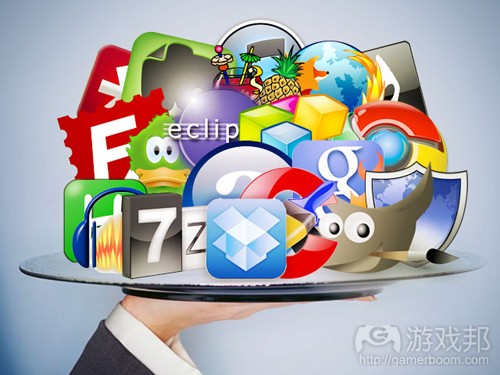|
作者:John Manoogian III 尽管对于开发者来说,面向苹果和Android应用商店创造应用是种非常赚钱的投资,但是应用开发者还必须做出一个非常复杂的决定,即如何做才能让应用赚钱。通常情况下“盈利策略”(也就是“怎么做才能让这款应用获得收益?”)总是被搁在最后。 让用户在上百万款现有的应用中找到你的产品是件非常困难的事,更别说说服他们去购买应用了。现在的玩家越来越喜欢在平板电脑和智能手机上购买广告赞助的免费应用,但是许多开发者却仍不懂得处理免费与付费应用间所存在的问题。决定何时对用户收钱以及何时使用广告赞助模式都是开发者必须考虑的最复杂问题之一。  free apps(from permeative.com)
面向应用的四大盈利策略,好吧,事实上只有2个。 开发者总是拥有各种可行的盈利选择,并且每种选择都有其需求和误区。 在解答“怎么做才能让我的应用获益”之前,应用开发者必须先搞清楚几个问题。 1.用户在频繁使用了我的应用后是否还会觉得它有趣? 2.人们是否愿意为我的应用预先支付相关费用? 3.竞争者是如何利用他们的应用盈利,并且他们的策略是如何获得成功的? 随着跨平台应用市场的发展,开发者可以通过相互交流而明确最佳盈利模式方法。以下便是4大盈利选择: 1.在应用商店中销售你的应用 2.提供订阅式的免费应用 3.提供基于应用内部购买的免费应用 4.提供由广告赞助的免费应用 这四个选择其实可以归结为两大策略:用户付钱或广告商付钱。 谁能为应用带来更多收益:是用户还是广告商?(也就是说哪种盈利策略更赚钱:免费还是付费?) 大量Android和iOS用户都不愿为应用花钱——不管是花钱买应用,订阅还是购买附加内容,所以智能手机和平板电脑开发者便只能转向广告模式。广告商比用户更愿意为开发者掏腰包。因为与开发者一样,广告商也需要面向市场去推广自己的产品。 广告能为应用带来多少收益? 越来越多广告商选择在各类应用中进行投入(游戏邦注:不管是手机上还是台式电脑)。但是大多数行业分析家一般只计算他们在手机应用中的广告支出,因为大多数应用都是面向于手机和智能手机设备。在2011年手机广告收益便提高了将近1.5倍,全年达到了16亿美元。 如此看来应用盈利的未来趋势就是广告赞助模式。剑桥大学计算机科学专家最近的研究表明,Android市场中有73%的应用是免费的,而在这些应用中更有80%将广告赞助当成主要的商业模式。根据研究,免费应用拥有更高的下载量。只有20%的付费应用的下载次数超过了100次,仅有0.2%付费应用下载次数超过1万次。而与之相反的是有20%免费应用获得了超过1万次的下载量。 最大的好处是:你可以使用多种盈利策略 尽管免费应用吸引了大量不愿花钱的用户,但这个市场还有一些选择无广告付费应用版本的用户。 开发者可以在应用开发时使用一种双管齐下的方法去吸引这两类用户的注意:同时创造出免费版本和付费版本。这种多管齐下的方法非常受发行行业巨头的欢迎。例如英国《卫报》正在测试两种应用:广告赞助的免费Anroid应用和只提供付费服务的iPhone应用。Echofon(游戏邦注:一款老牌的Twitter客户端应用)也同时迎合了两种类型的用户。对于所有平台上的Twitter应用它们同时设置了免费和付费两种版本。 总之,我们必须在发布一款新应用前更深入地研究各种广告赞助选项。可供开发者使用的广告网络多种多样,而我们需要做的便是对比不同平台所提供的千人成本(CPM)或每点击成本(CPC),并明确将广告整合进你的应用中需要花费多少精力。 更重要的是,你需要考虑到添加了广告后是否会影响用户体验。毕竟你也希望广告能够有效地与用户体验相整合,而不是让玩家感到厌烦并转身离开。(本文为游戏邦/gamerboom.com编译,拒绝任何不保留版权的转载,如需转载请联系:游戏邦) How Free Apps Can Make More Money Than Paid Apps John Manoogian III Editor’s note: John Manoogian III is co-founder and CTO at 140 Proof, a venture-backed startup for targeted Twitter advertising. While building apps for Apple and Android app stores can be highly lucrative ventures for developers, one of the hardest decisions an app developer has to make is how to get the app to pay for itself. Often the “monetization strategy” — shorthand for “how will this app make money?” — is left for last. It’s hard enough to get discovered by consumers among the millions of already existing apps, not to mention convince people to buy it. People increasingly prefer free, ad-supported apps for their tablets and smartphones, yet many developers still aren’t sure how to tackle the free vs. paid issue. Deciding when to charge for your app, and when to try an ad-supported model, is one of the hardest decisions developers must make. Four Monetization Strategies for Apps? Actually, There Are Only Two. Developers have several monetization options available, each with its own requirements and pitfalls. Before moving forward with a strategy though, there are a few of questions an app developer should explore in order to answer the ultimate question, “how can I monetize my app?” 1.Is my app engaging enough for people to use it often? 2.How willing are people to pay an up-front fee for my app? 3.How do competitors in my space monetize their apps, and how successful are their strategies? As app markets across platforms explode, developers are talking to each other to determine the best type of monetization model to use. Most will tell you it’s a choice among four major options: 1.selling your app in the app store 2.offering a free, subscription-supported app 3.offering a free app, with in-app purchases 4.offering a free, ad-supported app But the choice really boils down to two strategies: getting paid by users or getting paid by advertisers. Who Pays More for Apps: Users or Advertisers? (AKA Which Monetization Strategy Makes More Money: Free or Paid? When it comes to users, the overwhelming majority of Android and iOS users resist paying — whether it’s for apps, subscriptions, or add-ons–so smartphone and tablet developers are particularly interested in experimenting with monetization through ads. On the other hand, advertisers are MUCH more willing to pay developers than users are. Just like developers, advertisers need to market their product. How Much Money Can an App Make With Advertising? Ad spending on apps of all kinds – both mobile and desktop — is growing. Most industry analysts choose to measure only mobile app spending though, as most apps are created for the mobile and smartphone space. Mobile advertising revenue increased nearly 1.5X in 2011, to top out at $1.6 billion for the year. The future of app monetization clearly lies in ad-supported model. A recent study by Cambridge University computer scientists found that 73% of apps in the Android marketplace were free, and of those, 80% relied on advertising as their main business model. Free apps are also far more popular in terms of downloads, the researchers said. Just 20% of paid apps are downloaded more than 100 times and only 0.2% of paid apps are downloaded more than 10,000 times. On the flipside, 20% of free apps get 10,000 or more downloads. The Best Part Is: You Can Deploy Multiple Monetization Strategies While free apps reach the majority of users who tend to be price-sensitive and almost never buy apps, there is a subset of users who prefer to avoid advertising and seek paid (sometimes called “pro”) versions of their favorite apps. Developers can cater to both types of users with a two-pronged approach to app development: create both a free version and a paid version. The multi-pronged approach is popular with big players in the publishing industry. For example, The Guardian (UK) is testing two apps: a free, ad-supported Android app and a paid-only iPhone app. Echofon is also a great example of an app that caters to both kinds of users. They have free and paid apps for all platform versions of their Twitter apps. In short, before moving forward, investigate all ad-supported revenue options when you launch a new app. There are many ad networks available – shop around and see what CPMs (cost per thousand impressions) or CPCs (cost per click) they offer and how much work is involved integrating ads into your app. And more than anything, make sure to consider any changes to the user experience that will occur if you introduce by the ads. After all, you want ads that integrate well into the user experience, rather than ads that drive users away in annoyance.(source:techcrunch) |